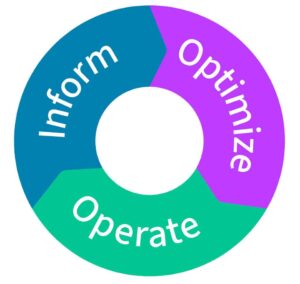Harnessing FinOps for Cloud Financial Management: A Cprime Perspective
FinOps FAQs addressed in this article:
-
What is FinOps? – FinOps, or Cloud Financial Management, is a practice designed to bring financial accountability to the variable spending model of cloud computing. It combines systems, best practices, and principles to help organizations understand cloud costs and make informed decisions.
-
What are the core principles of FinOps? – The six core principles of FinOps include: Teams need to collaborate, everyone takes ownership of their cloud usage, a centralized team drives FinOps, decisions are driven by the business value of cloud, real-time decisions require real-time data, and taking advantage of the variable cost model of cloud.
-
What are the three phases of the FinOps lifecycle? – The FinOps lifecycle consists of three phases: Inform, Optimize, and Operate. Each phase plays a critical role in managing cloud spend, from gaining visibility into costs and usage to optimizing resources and automating financial operations.
-
How does Cprime approach FinOps? – Cprime leverages its partnership with Apptio and expertise in FinOps to offer customized implementations, foster cross-functional collaboration, build a culture of accountability, and ensure continuous learning and improvement in cloud financial management.
-
What are some key FinOps practices and strategies? – Key FinOps practices include allocating costs back to the business, using hosting constructs for accounts, subscriptions, and projects, implementing resource tagging, applying business rules, rightsizing cloud resources, reducing rates with commitment-based discounts, and extending FinOps to containerized workloads.
-
How can organizations accelerate their FinOps journey? – Organizations can accelerate their FinOps journey by partnering with Cprime for a tailored FinOps maturity assessment, adopting a crawl, walk, run approach, implementing best practices and tools, and receiving continuous support and optimization.
-
Why is FinOps important for modern businesses? – FinOps is crucial for modern businesses as it enables them to manage and optimize cloud costs effectively, ensuring financial accountability, operational excellence, and strategic alignment with business objectives in a cloud-centric world.
-
What benefits does FinOps offer? – FinOps offers benefits such as improved decision-making through visibility into financial portfolios, optimized resource allocation, risk mitigation, governance, accountability, and the ability to align cloud investments with business goals for maximum ROI.
In today’s rapidly evolving digital landscape, the adoption of cloud services has become a cornerstone for businesses seeking agility, scalability, and innovation. As organizations migrate more of their operations to the cloud, managing the financial aspects of cloud computing has emerged as a critical challenge.
The shift from capital expenditure (CapEx) to operational expenditure (OpEx) models, while offering flexibility, also demands a more nuanced approach to budgeting, spending, and optimizing cloud costs. Enter FinOps, a strategic practice designed to bring financial accountability to the variable spend model of cloud services, ensuring that businesses can maximize the value of their cloud investments without compromising on speed or quality.
At Cprime, an experienced Apptio partner and FinOps expert, we understand the complexities and opportunities that come with managing cloud finances. Our deep expertise in implementing FinOps practices, combined with our strategic partnership with Apptio, positions us uniquely to guide organizations through the intricacies of cloud financial management.
This blog post aims to demystify FinOps, exploring its principles, lifecycle, and the transformative impact it can have on your organization’s approach to cloud spending. With Cprime’s perspective, we’ll delve into how businesses can harness FinOps to not only manage but optimize their cloud financials for sustained growth and efficiency.
The Rise of Cloud Computing
The digital transformation journey has led many organizations to embrace cloud computing, a shift that has fundamentally changed how businesses operate and innovate. Recent years have seen a significant surge in cloud adoption, with companies leveraging cloud services for their flexibility, scalability, and the ability to drive innovation. This trend has only accelerated in the wake of the COVID-19 pandemic, as businesses sought to adapt to new ways of working and serving their customers.
One of the most significant shifts in moving to the cloud is the transition from capital expenditure (CapEx) to operational expenditure (OpEx). Traditional IT spending involved significant upfront investments in hardware and infrastructure, whereas cloud computing operates on a pay-as-you-go model, where expenses are incurred based on usage. This model offers businesses the agility to scale up or down based on demand, but it also introduces new challenges in managing and optimizing cloud costs.
The rapid growth of cloud services has underscored the need for effective financial management practices. As organizations navigate this new landscape, the ability to monitor, analyze, and optimize cloud spending becomes crucial. This is where FinOps comes into play, offering a framework for businesses to achieve financial accountability and make informed decisions about their cloud investments. By embracing FinOps, companies can ensure that their cloud strategy is not only efficient but also aligned with their broader business objectives.
Understanding FinOps
FinOps, or Cloud Financial Management, is a practice designed to bring financial accountability to the variable spending model of cloud computing. It represents a cultural shift that combines systems, best practices, and principles to help organizations understand cloud costs and make informed decisions. The goal of FinOps is to enable teams to balance speed, cost, and quality, ensuring that cloud investments deliver the maximum value to the business.
At the heart of FinOps are six core principles that guide organizations in managing their cloud spend effectively:
- Teams Need to Collaborate: FinOps fosters a culture of collaboration across finance, technology, and business teams, ensuring everyone is aligned on financial goals.
- Everyone Takes Ownership of Their Cloud Usage: It empowers individuals and teams to take responsibility for their cloud consumption, encouraging accountability and cost-awareness.
- A Centralized Team Drives FinOps: While collaboration is key, a dedicated FinOps team is essential to drive best practices, standardize reporting, and lead optimization efforts.
- Decisions are Driven by the Business Value of Cloud: Organizations prioritize investments based on the value delivered to the business, ensuring that cloud spending aligns with strategic objectives.
- Real-Time Decisions Require Real-Time Data: Access to timely and accurate data is crucial for making informed decisions about cloud usage and optimization.
- Take Advantage of the Variable Cost Model of Cloud: FinOps practices help organizations leverage the cloud’s flexibility to optimize costs without sacrificing performance or innovation.
These principles lay the foundation for the FinOps lifecycle, which consists of three iterative phases. Each phase plays a critical role in helping organizations manage their cloud spend, from gaining visibility into costs and usage to optimizing resources and automating financial operations. By adhering to these principles and navigating the FinOps lifecycle, businesses can ensure that their cloud strategy is both cost-effective and aligned with their overall goals.
The FinOps Lifecycle
The implementation of FinOps within an organization unfolds through a structured lifecycle comprising three key phases: Inform, Optimize, and Operate. This cyclical process ensures continuous improvement and alignment between cloud investments and business objectives. Here’s a closer look at each phase:
Inform Phase:
The primary goal is to provide visibility into cloud spending and usage across the organization.
It involves allocating cloud costs to the appropriate business units, projects, or teams, making it clear who is spending what.
This phase encourages accountability by showing teams their direct impact on cloud costs, fostering a culture where every team member understands the financial implications of their cloud usage.
Optimize Phase:
Once visibility is established, the next step is to optimize cloud usage and costs. This phase focuses on ensuring that cloud resources are used efficiently.
Key activities include rightsizing resources to match workload demands, selecting the most cost-effective pricing options, and identifying unused or underutilized resources for decommissioning.
The optimize phase is about making informed decisions to reduce waste and improve cost efficiency without compromising on performance or scalability.
Operate Phase:
The operate phase is where processes and policies are put into action to achieve the organization’s cloud financial management goals.
It involves automating cost optimization practices, implementing governance policies to control cloud spend, and integrating financial management into the broader operational framework.
This phase ensures that FinOps becomes an integral part of the organization’s operational rhythm, enabling continuous monitoring, management, and optimization of cloud costs.
The FinOps lifecycle is inherently iterative. Organizations are encouraged to start small and gradually expand their FinOps practices as they mature. This approach allows businesses to learn from each cycle, making incremental improvements that lead to significant cost savings and efficiency gains over time. By continuously cycling through the Inform, Optimize, and Operate phases, companies can ensure that their cloud spending is always aligned with their strategic goals, delivering maximum value to the business.
Cprime’s Approach to FinOps
Cprime, leveraging its extensive experience as an Apptio partner and FinOps expert, adopts a comprehensive approach to cloud financial management that aligns with the dynamic needs of modern businesses. Our methodology is rooted in a deep understanding of the FinOps lifecycle, tailored to help organizations navigate the complexities of cloud spending effectively. Here’s how Cprime makes a difference:
- Strategic Partnership with Apptio: Cprime utilizes its strategic partnership with Apptio to bring cutting-edge technology and insights into cloud financial management. Apptio’s tools provide granular visibility into cloud costs and investments, enabling data-driven decisions that optimize cloud spending.
- Customized FinOps Implementation: Recognizing that each organization has unique needs, Cprime offers customized FinOps implementations. We work closely with our clients to understand their specific challenges and objectives, ensuring that our FinOps strategies are perfectly aligned with their business goals.
- Empowering Cross-Functional Collaboration: At the core of our approach is the emphasis on fostering collaboration across finance, technology, and business teams. Cprime helps break down silos, ensuring that all stakeholders are engaged in the FinOps process and understand their role in managing cloud costs.
- Building a Culture of Accountability: Cprime focuses on building a culture of financial accountability within organizations. By empowering teams with the knowledge and tools they need to manage their cloud usage, we encourage a sense of ownership and responsibility for cloud costs.
- Continuous Learning and Improvement: The cloud landscape is constantly evolving, and so are the best practices for managing cloud finances. Cprime is committed to continuous learning and improvement, keeping our clients informed about the latest trends and techniques in FinOps. We ensure that our clients are always at the forefront of cloud financial management.
By partnering with Cprime, organizations can confidently navigate their cloud financial management journey, leveraging our expertise, tools, and methodologies to maximize the value of their cloud investments. Whether you’re just starting with FinOps or looking to refine your existing practices, Cprime is here to guide you every step of the way.
Key FinOps Practices and Strategies
Implementing FinOps effectively requires a blend of strategic practices and operational tactics. Here are some key practices and strategies that Cprime advocates for optimizing cloud financial management:
- Allocating Costs Back to the Business: Essential to the FinOps framework is the ability to accurately allocate cloud costs to the correct business units, projects, or teams. This transparency ensures that every stakeholder understands their cloud spending and its impact on the overall budget.
- Hosting Constructs for Accounts, Subscriptions, and Projects: Utilizing hosting constructs such as accounts (AWS), subscriptions (Azure), or projects (Google Cloud) is a foundational step in organizing cloud spend. This structure allows for a clear delineation of costs and usage, facilitating easier allocation and reporting.
- Resource Tagging: Implementing a comprehensive resource tagging strategy is crucial for granular cost tracking and allocation. Tags enable organizations to categorize cloud resources by project, environment, or any other relevant dimension, enhancing visibility and control over cloud spend.
- Applying Business Rules: Business rules help automate the allocation of costs and the enforcement of policies related to cloud spending. By defining and applying these rules, organizations can ensure consistent and accurate cost management practices across the board.
- Rightsizing Cloud Resources: Rightsizing involves adjusting the size of cloud resources to match workload requirements closely. This practice helps eliminate waste by ensuring that organizations are not over-provisioning resources, leading to significant cost savings.
- Reducing Rates with Commitment-Based Discounts: Taking advantage of commitment-based discounts, such as Reserved Instances (AWS) or Committed Use Discounts (Google Cloud), can lead to substantial reductions in cloud costs. These discounts reward long-term commitments with lower rates, offering an effective way to optimize spending.
- Extending FinOps to Containerized Workloads: As organizations increasingly adopt containerized workloads, extending FinOps practices to manage these costs becomes essential. This includes monitoring container usage, applying allocation and tagging strategies, and optimizing container resource allocation.
By integrating these practices into their FinOps strategy, organizations can achieve a more efficient, transparent, and accountable approach to cloud financial management. Cprime’s expertise in implementing these practices ensures that our clients can navigate the complexities of cloud spending, unlocking the full potential of their cloud investments.
Are You Ready to Get the Most Out of FinOps?
Whether you’re just beginning to explore FinOps or looking to enhance your existing practices, Cprime is here to accelerate your journey. Our goal is to empower your organization to achieve financial accountability, operational excellence, and strategic alignment in your cloud investments, ensuring you realize the full potential of your cloud strategy.
If you’re ready to take control of your cloud spending, optimize your cloud investments, and foster a culture of financial accountability within your organization, it’s time to speak to a FinOps expert. Together, we can transform your cloud financial management practices and unlock the full potential of your cloud strategy.


